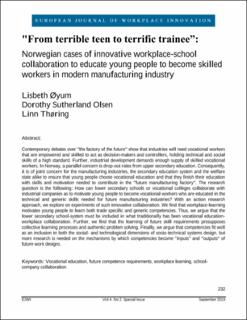| dc.contributor.author | Øyum, Lisbeth | |
| dc.contributor.author | Olsen, Dorothy Sutherland | |
| dc.contributor.author | Thøring, Linn | |
| dc.date.accessioned | 2020-03-27T15:15:03Z | |
| dc.date.available | 2020-03-27T15:15:03Z | |
| dc.date.created | 2020-03-23T12:17:52Z | |
| dc.date.issued | 2019 | |
| dc.identifier.citation | Øyum, L., Olsen, D. S. & Thøring, L. (2019). "From terrible teen to terrific trainee": Norwegian cases of innovative workplace-school collaboration to educate young people to become skilled workers in modern manufacturing industry. European Journal of Workplace Innovation, 4(2), 232-251. | en_US |
| dc.identifier.issn | 2387-4570 | |
| dc.identifier.uri | https://hdl.handle.net/11250/2649188 | |
| dc.description.abstract | Contemporary debates over "the factory of the future" show that industries will need vocational workers that are empowered and skilled to act as decision-makers and controllers, holding technical and social skills of a high standard. Further, industrial development demands enough supply of skilled vocational workers. In Norway, a parallel concern is drop-out rates from upper secondary education. Consequently, it is of joint concern for the manufacturing industries, the secondary education system and the welfare state alike to ensure that young people choose vocational education and that they finish their education with skills and motivation needed to contribute in the "future manufacturing factory". The research question is the following: How can lower secondary schools or vocational colleges collaborate with industrial companies as to motivate young people to become vocational workers who are educated in the technical and generic skills needed for future manufacturing industries? With an action research approach, we explore on experiments of such innovative collaboration. We find that workplace-learning motivates young people to learn both trade specific and generic competencies. Thus, we argue that the lower secondary school-system must be included in what traditionally has been vocational education-workplace collaboration. Further, we find that the learning of future skill requirements presupposes collective learning processes and authentic problem solving. Finally, we argue that competencies fit well as an inclusion in both the social- and technological dimensions of socio-technical systems design, but more research is needed on the mechanisms by which competencies become "inputs" and "outputs" of future work designs. | en_US |
| dc.language.iso | eng | en_US |
| dc.publisher | University of Agder | en_US |
| dc.relation.uri | https://journal.uia.no/index.php/EJWI/article/view/58 | |
| dc.rights | Navngivelse 4.0 Internasjonal | * |
| dc.rights.uri | http://creativecommons.org/licenses/by/4.0/deed.no | * |
| dc.subject | Vocational education | en_US |
| dc.subject | Future competence requirements | en_US |
| dc.subject | Workplace learning | en_US |
| dc.subject | School-company collaboration | en_US |
| dc.title | "From terrible teen to terrific trainee": Norwegian cases of innovative workplace-school collaboration to educate young people to become skilled workers in modern manufacturing industry | en_US |
| dc.type | Peer reviewed | en_US |
| dc.type | Journal article | en_US |
| dc.description.version | publishedVersion | en_US |
| dc.source.pagenumber | 232-251 | en_US |
| dc.source.volume | 4 | en_US |
| dc.source.journal | European Journal of Workplace Innovation | en_US |
| dc.source.issue | 2 | en_US |
| dc.identifier.cristin | 1802962 | |
| cristin.ispublished | true | |
| cristin.fulltext | original | |
| cristin.qualitycode | 1 | |

